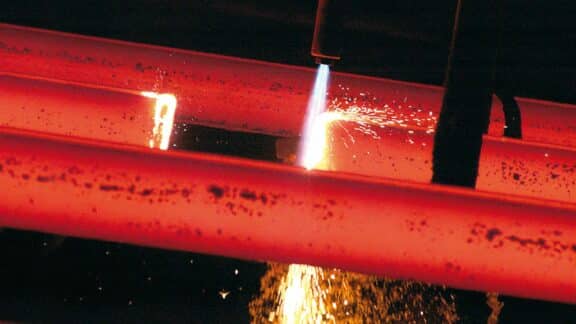This post is also available in: 简体中文 (Chinese (Simplified))
Many of the issues affecting blast-furnace operation are related to premature wear of the furnace’s hot face and failure of the cooling-pipe connections. The experts from Primetals Technologies have studied these issues in detail and created new copper staves that not only significantly increases furnace lifetime and reliability but also improves overall furnace-cooling efficiency.
Since the late 19th century, when the rapid increase in blast-furnace capacity brought about the use of steel shells, the shell-water cooling system has been an important factor in extending the life of a blast furnace’s operating campaign. Increasing furnace operating pressures and the incorporation of a free-standing design necessitated increases in furnace-shell thickness and required greater reliability of the cooling systems, in order to ensure the structural integrity of the blast furnace could be maintained.
In the mid-twentieth century, the predominant cooling system relied on copper-plate coolers inserted through the shell, but as campaign durations increased, the limitations of this plate-cooler solution led to its replacement with a cast-iron stave solution that facilitated full cooling coverage of the shell. Initially developed in Russia and further enhanced through developments within Japan, the stave solution allowed for more consistent campaigns.
As blast-furnace development continued, the drive for even longer campaigns with higher productivities began to expose certain limitations in the functionality of cast-iron staves within the higher heat-load zones of the furnace. In order to improve the heat-removal capabilities of these areas, copper staves were introduced that increased the ability of the cooling system to handle higher heat loads.
Although copper staves have—in many plants—proven to be very reliable in protecting the structural integrity of the pressure vessel, there are multiple instances in which premature failure has led to significant furnace downtime with associated costs. Developing an understanding of these failure modes was part of the continued search for an ideal cooling solution to protect the integrity of the blast furnace shell.
Common issues with copper staves
From the early testing of copper staves, the ability to form a protective layer during operation was seen as critical in promoting a long campaign life. The superior thermal conductivity of copper allows for rapid freezing of liquid phases on the front face of the stave, thus building up a layer that can protect against the impact of other moving unreduced burden materials. Once formed, the accretion layer also provides additional insulation against the thermal movements within the furnace. The robustness of this accretion layer is therefore very important in avoiding constant exposure of the softer copper front face to both descending solids and ascending hot gases.
As a leader in copper-stave design, Primetals Technologies was asked by a number of steel companies to investigate issues they were experiencing where the copper staves provided by third-party suppliers were unable to deliver the expected performance. The type of issues experienced generally fell into three main areas:
- Manufacturing faults
- Premature wear of the hot face
- Failure of the cooling-pipe connections
It was found that issues caused by manufacturing faults usually stem from a failure to ensure that quality-assurance and quality-control requirements are established and then fully monitored during the manufacture and supply of the staves. For that reason, this article will focus on issues unrelated to manufacturing faults.
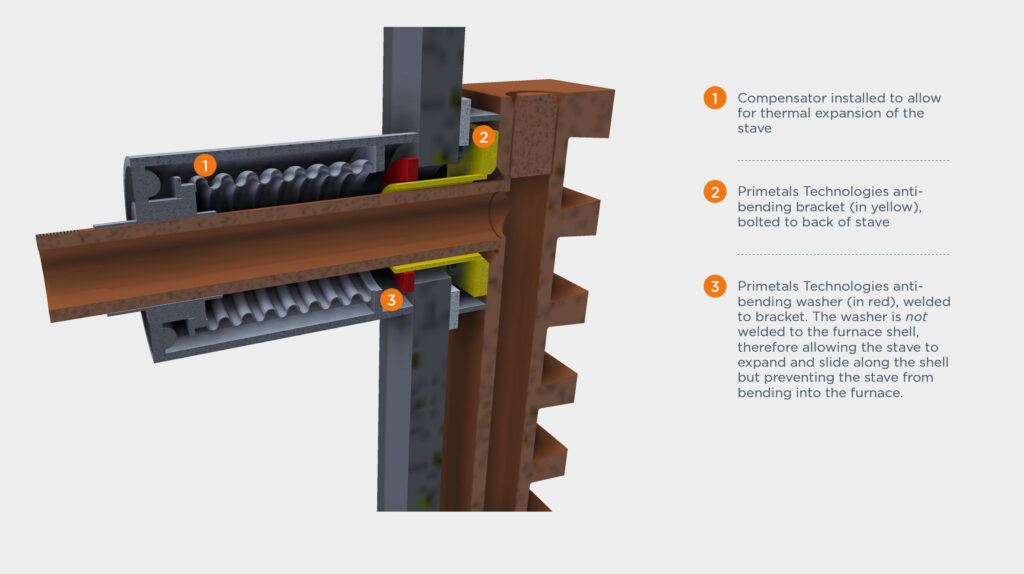
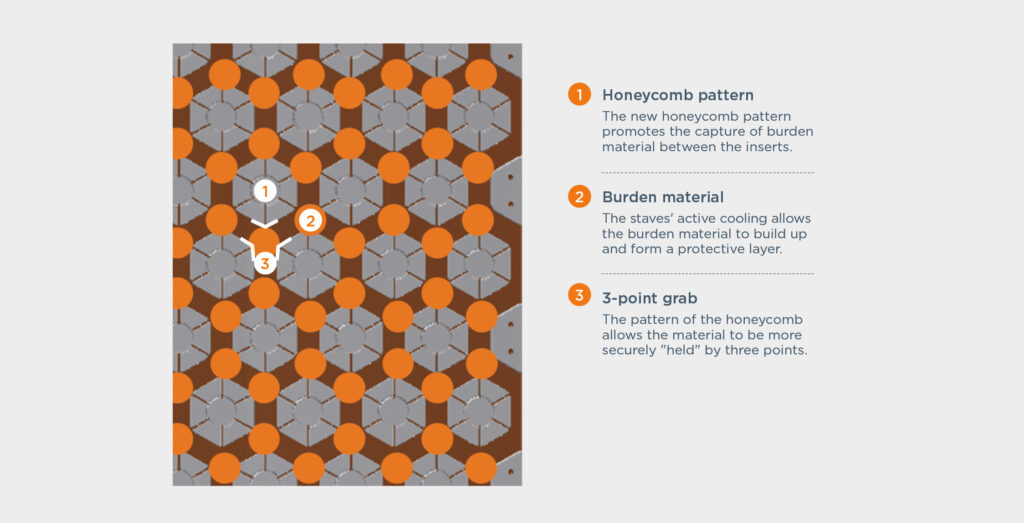
Copper-stave wear
Premature wear of the stave hot face is not a phenomenon detected in all copper-stave furnace installations and therefore is likely to be a combination of a variety of factors. Over the course of several plant investigations, Primetals Technologies encountered designs where the furnace profile was optimized for size rather than for good furnace operation. This was first observed in rebuilds but was also seen in new furnaces with designs that incorporated profiles from rebuilt furnaces.
The main cause of loss from the stave hot face is abrasive wear from unreduced burden materials moving down the furnace with varying forces transmitted through the solid layers normal to the face. Uncontrolled wall temperatures also weaken the stave material and promote increased abrasive wear. An incorrect furnace profile can bring about conditions that lead to excessive wear—but these conditions can also occur as a result of other events, such as furnace-process disturbances, changes in position of the cohesive zone, high rates of reductant injection, errors in furnace-charging patterns, and poor burden quality.
Excessive wear can cause water leaks into the furnace through exposure of the cooling-water channels and ultimately the complete loss of the stave and shell damage. The rate of wear has been seen to increase rapidly under certain conditions and to be reduced again by process adjustments. This shows that certain operational input is critical. Leakage can be temporarily arrested by the insertion of flexible pipes or through the use of nitrogen injection, but ultimately a replacement of the stave will often be required.
Therefore, in order to avoid wear problems and ensure a correct furnace profile, it is important to try to promote the build-up of an accretion on the stave front face and to ensure it either has a permanent presence or is swiftly replaced when lost.
Copper-stave bending
Relatively prevalent in current installations but with some external remedial measures is the failure of cooling-water pipes through stave bending. Thermally, the copper stave experiences a controlled cold-face temperature driven by the cooling-water system and a higher hot-face temperature that varies significantly during day-to-day operations. This thermal variation results in the stave relieving expansion stresses and—without control measures—causes stave bending. Rapid changes of temperature due to variations in furnace conditions or the loss of the protective layer force the stave temperature to cycle and deflect at the points where the stave is least restrained.
Deflection of staves at their corners is a relatively common issue that allows material to get behind the stave and then enter into the bellows of the compensator. In these instances, the compensator, which is installed around the stave pipes to allow for stave movements, becomes blocked and locks the pipes in place, causing stress of the welded connection between the pipe and the stave body. As thermal cycling continues, further bending occurs, resulting in more material getting behind the stave. This cycling results in failure of the weld connection of the water pipe to the stave body and ultimately in cooling-water leakage into the furnace.
Primetals Technologies closely examined this problem and determined that it was crucial for new copper-stave designs to include provision to handle these movements in such a way that the areas of the cooling pipes and joints are not compromised. Existing measures to help control the bending had thus far focused on improving the details of ribs and grooves, and on repairing any compromised staves.
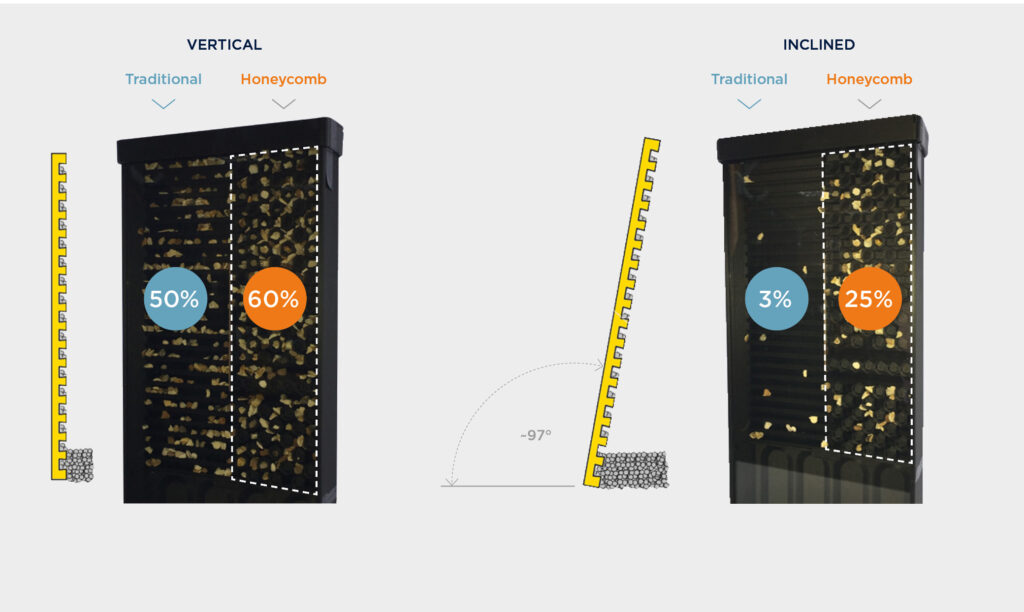
The next-generation copper staves
Based on the experience gained from numerous successful blast-furnace installations and many failure investigations of third-party furnaces, Primetals Technologies developed a new design concept for the next-generation copper stave.
The basic stave design essentially remains the same in terms of size limitations and thickness, which means that engineering solutions must still be included to cater for bending phenomena. The anti-bending solution previously employed by Primetals Technologies is therefore still part of the new stave design and allows the cooling pipes to move during thermal expansion but prevents any bending of the stave corners inwards (see Figure 2).
This solution prevents the fatigue failures associated with other designs. The original concept of this bracket was implemented to great success with campaign durations of 15 years or more. Later versions were incorporated in other furnaces and are now included as part of the standard stave from Primetals Technologies. This stave is not prone to bending issues thanks to the incorporation of the anti-bending solution in conjunction with other critical design parameters responsible for the correct positioning of the fixed and moving pins.
The wear mechanism requires other adjustments. It is known at the outset of a campaign that a correct furnace profile is very important for avoiding wear issues, and this must always be the starting point in correct stave design. However, once furnace operation is in full effect, it is always likely for process conditions to change on both short and long timescales. As furnace operators push for higher productivities and longer campaigns, the staves have to cope with ever-more arduous conditions. The staves therefore require additional protection against wear, and their design must take into account the possibility of changes in raw-material type and quality during a long campaign.
The best way of protecting a copper stave against wear in operation is to ensure that a protective layer can not only build up on the front face but rapidly reforms during process excursions and reaches an extended lifetime. The technology specialists of Primetals Technologies have looked at how to make this layer more robust and concluded that the original rib concepts, which followed from the original cast-iron stave development, could be modified in order to improve the hold on the protective layer. A different arrangement was considered to lock the layer in place, and this led to the development of the honeycomb stave.
Making use of modern machining techniques allows for much more complex patterns to be formed on the stave hot face. After evaluating many different arrangements and shapes, it was the honeycomb pattern that stood out as the most advantageous.
In this arrangement, the bare stave has a machined honeycomb pattern, which on its own forms discrete pockets for adherence of an accretion material. The design of these pockets was engineered in a way that would enable the retention of hexagonal inserts of a metallic or ceramic wear-resistant material. This was done because the pattern of the hexagonal inserts acts in a similar way to existing staves, either providing a stone-box effect with unreduced burden material or utilizing the excellent cooling of the copper face to freeze on a protective accretion layer. The honeycomb arrangement, however, promotes the capture of the material between the inserts, allowing the material to be more securely held by three points (see Figure 3).
It was established that this 3-point hold mechanism would provide better support for any protective layer developed on the copper staves, thus improving the robustness and durability of the stave overall. The Primetals Technologies team then produced scale models to demonstrate the design concept. When testing a current stave design against the new arrangement, the initial hold is similar, but as the inclined plane shows, the material is held much better by the honeycomb pattern (see Figure 4). In a real situation where the material is likely to be a mix of gases, liquids, and solids, this will produce a far more robust protective layer..
As an alternative to the completely new stave design, Primetals Technologies also considered an incremental change to the existing stave design in order to achieve the new benefits without changing the base stave. This takes an existing Primetals Technologies standard stave (left) and incorporates sliding inserts of single-piece inserts and spacers to produce the same honeycomb arrangement (right). The core benefits of the new copper-stave design are thus maintained.
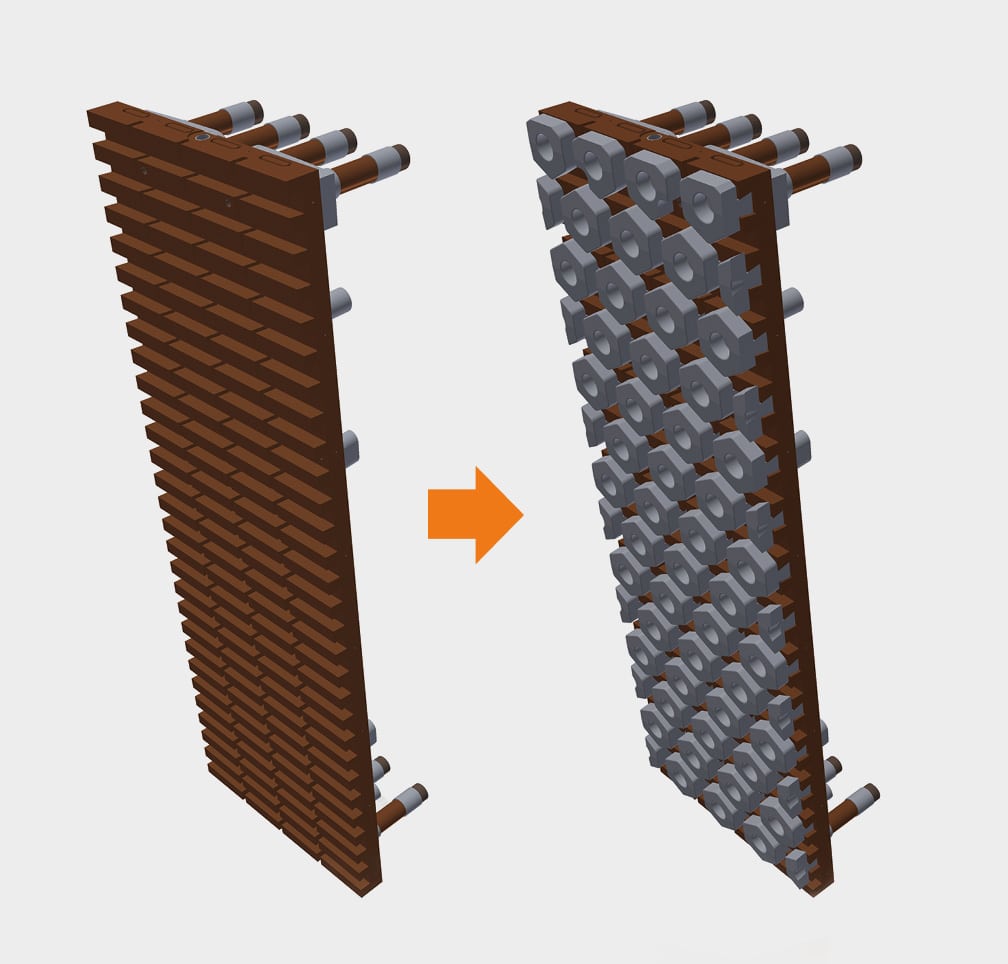
Stave Portfolio Summary
As a leading supplier of copper-stave designs, Primetals Technologies continues to develop blast-furnace cooling solutions to meet the expectations of today’s steel producers for long, consistent campaigns. Although standard features are important, Primetals Technologies has found over time that optimal furnace-cooling design starts with understanding the furnace profile and process conditions. The new stave developments will allow this understanding to be applied flexibly through different materials, shapes, and arrangements to provide even more stable operation.

